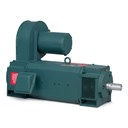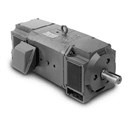Carl; I had nothing to do with your post being deleted. I was a little surprised to see it gone.
My only issue and it is an indirect issue is with this statement;
iceworm said:
Series DC motors will burn themselves into a molten pile of slag before they quit.
Actually I agree with your statement.
Example; The starter was shot on the generator for a remote mining camp.
It would barely start the diesel when cold and not at all when the starter was hot.
One field coil was so badly grounded that it was disconnected and only one field coil was in use.
We needed the set running and didn't have hours to wait for the starter to get cold.
Three 8D batteries in series for 36 Volts to a 12 Volt series motor and we got the set started.
The next morning, cold, the set started on 12 Volts.
What you said. Rugged as a hammer.
My issue is that your statement seems to imply that a series DC motor was used.
That would not be the case.
Those MG set DC drives were quite common.
They would not drive a series motor.
The motors used are shunt motors.
The shunt field is continually excited with the rated voltage.
The armature is fed a variable and reversible voltage.
Wher do you get the variable voltage? from a DC generator.
How do you control the voltage?
By varying the generator excitation.
The generator armature is directly connected to the motor armature.
Looking at it from a voltage point of view it may be a parallel connection.
Looking at it from a current point of view it may be a series connection.
Looking at it physically it may look like a series connection.
Doesn't matter.
It is a shunt motor.
Where was I in those years?
There was not much work in those years, mostly short term contracts.
Some volunteer work near Lac La Barge, Yukon Territory.
A placer mine in British Columbia. (And the melting down starter.)
An oil re-refinery in Ontario,
Gm Oshawa.
Darlington Neuclear plant.
When PLCs were first on the market, I heard an older engineer complain.
These young guys and PLCs.
They would use a PLC to flush a toilet if they could get away with it.
No, I would have tried to upgrade the existing system.
Something like this;
And this for the generator.
Bill
--------------------
"Why not the best?"
Jimmy Carter

![[bigsmile] [bigsmile] [bigsmile]](/data/assets/smilies/bigsmile.gif) I'll give it a start. You need to find out the speed and torque your current motor puts out. Do you need the same speed/torque characteristics? An AC motor controller can give you lots of options for speed and torque limits.
I'll give it a start. You need to find out the speed and torque your current motor puts out. Do you need the same speed/torque characteristics? An AC motor controller can give you lots of options for speed and torque limits.
